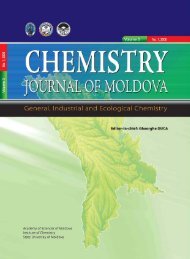2011, nr. 1 - Academia de Ştiinţe a Moldovei
2011, nr. 1 - Academia de Ştiinţe a Moldovei
2011, nr. 1 - Academia de Ştiinţe a Moldovei
Create successful ePaper yourself
Turn your PDF publications into a flip-book with our unique Google optimized e-Paper software.
<strong>Ştiinţe</strong> Medicale<br />
the making of a tragedy and leșșonș learned. Mayo.<br />
Clin. Proc. 2005; 80: 1449–1460.<br />
3. Nirav A. Steven J.; Shook H. Ch. Schumacher,<br />
Andrew L. Tievsky, Greg W. Albers, Lawrence R.<br />
Wechsler and Rishi Gupta. A 5-Item Scale to Predict<br />
Stroke Outcome Aft er Cortical Middle Cerebral Artery<br />
Territory Infarction: Validation From Results of the<br />
Diff usion and Perfusion Imaging Evaluation for Un<strong>de</strong>rstanding<br />
Stroke Evolution (DEFUSE) Study. Stroke,<br />
<strong>2011</strong>; 42:645-649.<br />
4. Parsons M.W., Barber P.A., Desmond P.M., Baird<br />
T.A., Darby D.G., Byrnes G, Tress BM, Davis SM.<br />
Acute hyperglycemia adversely aff ects stroke outcome:<br />
a magnetic resonance imaging and spectroscopy study.<br />
Ann Neurol. 2002; 52:20–28.<br />
5. Weimar C., Ziegler A., KoЁnig I.R., Diener<br />
H.C. Predicting functional outcome and survival after<br />
acute ischemic stroke. J Neurol. 2002; 249:888–<br />
895.<br />
6. Dziedzic T., Sl A. Sowik, Pera J. and A. Szczudlik.<br />
Association between hyperglycemia, heart failure<br />
and mortality in stroke patients. European Journal of<br />
Neurology 2009, 16: 251–256.<br />
7. Brett L. Cucchiara, Scott E. Kasner, David<br />
A. Wolk, Patrick D. Ly<strong>de</strong>n, Volker A. Knappertz, Tim<br />
Așhwood, Tomaș O<strong>de</strong>rgren, An<strong>de</strong>rș Nordlund, Early<br />
impairment in conșciousness predicts mortality after<br />
hemispheric ischemic stroke Crit. Care Med., 2004;<br />
32:241–245.<br />
8. Bousser M.G., Dubois B, Castaigne P: Transient<br />
loss of consciousness in ișchaemic cerebral eventș: A<br />
ștudy of 557 ischaemic strokes and transient ischaemic<br />
attacks [author’s transl]. Ann. Med. Interne (Paris)<br />
1981; 132:300–305.<br />
9. Ferbert A., Bruckmann H., Drummen R. Clinical<br />
features of proven basilar artery occlusion. Stroke<br />
1990; 21:1135–1142.<br />
10. Steiner T., Ringleb P., Hacke W. Treatment<br />
options for large hemispheric stroke. Neurology, 2001;<br />
57:s61–s68.<br />
11. Ropper A. Lateral disșplacement of the brain<br />
and level of consciousness in patients with an acute hemispheral<br />
mass. N Engl J Med 1986; 314:953–958.<br />
12. Kasner S.E., Demchuk A.M., Berrouschot J.,<br />
et al: Predictors of fatal brain e<strong>de</strong>ma in massive hemispheric<br />
ischemic stroke. Stroke 2001; 32:2117–2123.<br />
13. Henon H., Go<strong>de</strong>froy O., Leys D. et al. Early<br />
predictors of <strong>de</strong>ath and disability aft er acute cerebral<br />
ischemic event. Stroke 1995; 26: 392–398.<br />
14. Rordorf G., Koroșhetz W., Efi rd J.T. et al Predictors<br />
of mortality in stroke patients admitted to an<br />
intensive care unit. Crit. Care. Med. 2000; 28:1301–<br />
1305.<br />
15. James L. Bernat: Chronic disor<strong>de</strong>rs of consciousness<br />
Lancet 2006; 367:1181–92.<br />
233<br />
Rezumat<br />
În Republica Moldova AVC sunt situate pe locul<br />
II în structura mortalităţii populaţiei. Tulburările <strong>de</strong><br />
conștienţă sunt frecvent asociate în cadrul AVC, în majoritatea<br />
cazurilor <strong>de</strong>terminând o evoluţie severă și un<br />
pronostic nefavorabil al maladiei. Mai multe mo<strong>de</strong>le <strong>de</strong><br />
predicţie au fost elaborate pentru pronosticarea stării<br />
pacienţilor cu AVC. Recent (<strong>2011</strong>) Nirav A. și colegii<br />
au implementat un mo<strong>de</strong>l nou și unic pentru pronosticul<br />
ictusului cerebral prin combinarea indicilor clinici,<br />
<strong>de</strong> laborator și a parametrilor radiologici, pentru<br />
a i<strong>de</strong>ntifi ca factorii care au impact asupra recuperării.<br />
Pacienţii <strong>de</strong> vârstă înaintată, nivel înalt la <strong>de</strong>but al scalei<br />
NIHSS, focar ischemic masiv, hiperglicemie timpurie și<br />
leucocitoză la spitalizare au un prognostic mai slab <strong>de</strong><br />
recuperare în cazul ictusurilor ischemice.<br />
Summary<br />
In the Republic of Moldova, cerebrovascular<br />
acci<strong>de</strong>nts (stroke is ) are placed on the 2 nd place in<br />
the structure of population mortality. Disor<strong>de</strong>rs<br />
of consciousness are frequently associated within<br />
strokes, in most cases causing a severe evolution<br />
and an unfavorable prognosis of the disease. Most<br />
of the accomplished studies, More predictive<br />
methods were <strong>de</strong>veloped for predicting outcomes<br />
of the patients with strokes. Recently, (<strong>2011</strong>) Nirav<br />
A. and his colleagues have implemented a new and<br />
unique method for the prediction of cerebral infarct<br />
prognostic by combining clinical in<strong>de</strong>xes, that of<br />
laboratory and radiological parameters that have an<br />
impact on recovery. Patients with advanced ages,<br />
with high level at the onset of NIHSS scale, massive<br />
ischemic focal, early hyperglycemia and leukocytosis<br />
on hospitalization have a worse prognosis of recovery<br />
in the ischemic strokes.<br />
Резюме<br />
В Республике Молдова в структуре смертности<br />
населения ишемический инсульт (ИИ) занимает<br />
II место. Нарушения сознания часто ассоциируются<br />
с ИИ, в большинстве случаев определяя<br />
тяжелое течение ИИ и неблагоприятный исход.<br />
Были созданы несколько моделей для прогнозирования<br />
результатов исхода у пациентов ИИ.<br />
Недавно (<strong>2011</strong>) A. Nirav и его коллеги внедрили<br />
новую и единственную модель прогноза исхода<br />
ИИ, комбинируя клинические показатели, лабораторные<br />
и радиологические параметры идентификации<br />
факторов, влияющих на восстановление<br />
пациентов. У пациентов в пожилом возрасте,<br />
с массивным ишемическим очагом, с высоким<br />
уровнем NIHSS в дебюте, гипергликемией и лейкоцитозом<br />
при госпитализации прогноз для восстановления<br />
при ИИ низкий.

















